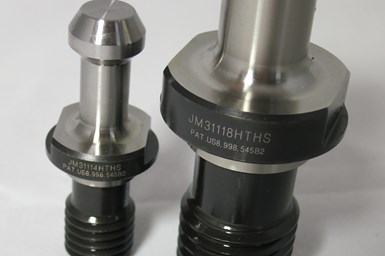JM Performance's High Torque Retention Knobs Lower Chatter
JM Performance Products has launched a specially designed High Torque retention knob for V-Flange tooling that the company says reduces chatter and tool wear.
Share





JM Performance Products Inc. (JMPP) says that its High Torque retention knobs solve many long-standing challenges of V-Flange tooling, including toolholder expansion and short tool life.
The company says V-Flange tooling’s troubles exist because steel maintains its elastic properties even after hardening, and threads create torsional stress. The stress exerted by the engagement of the threads of the retention knob with the threads of the V-Flange holder at the holder’s small end often distort the holder. Once expanded or distorted, the holder no longer pulls all the way into the spindle, stopping short of full engagement. This leads to the small end of the taper making contact before the large end at the gage line, allowing the holder to move randomly within the spindle in a manner JMPP describes as much like a bell-clapper.
This random movement translates to vibration and chatter, which negatively impact tool life. JMPP says toolholder expansion caused by standard retention knob installation reduces toolholder-to-spindle contact by 70% or more, and that carbide tool life diminishes by 50% for every .0005” distance short of full engagement. The company also says less than 75% taper contact with the spindle results in poor TIR (runout) and tolerances, as well as excessive spindle wear and tear.
JMPP’s High Torque retention knob uses the lowest available threads in the toolholder to prevent this issue, with a relief beneath the pilot especially important to the effectiveness of the design. The company says its design is compatible with any toolholder that meets industry specifications.
As the knobs are subject to high stress and wear, JMPP recommends replacing them after three years in single-shift settings, after two years for when operating the knobs for two shifts or after a single year of three-shift work.
Related Content
-
Rego-Fix’s Center for Machining Excellence Promotes Collaboration
The new space includes a showroom, office spaces and an auditorium that will enhance its work with its technical partners.
-
Simulation and Tooling Secure High-Value Work
Simulation software and careful attention to tooling parameters have enabled Major Tool to take on ambitious projects with its complex machinery.
-
How to Mitigate Chatter to Boost Machining Rates
There are usually better solutions to chatter than just reducing the feed rate. Through vibration analysis, the chatter problem can be solved, enabling much higher metal removal rates, better quality and longer tool life.
























.jpg;maxWidth=300;quality=90)
